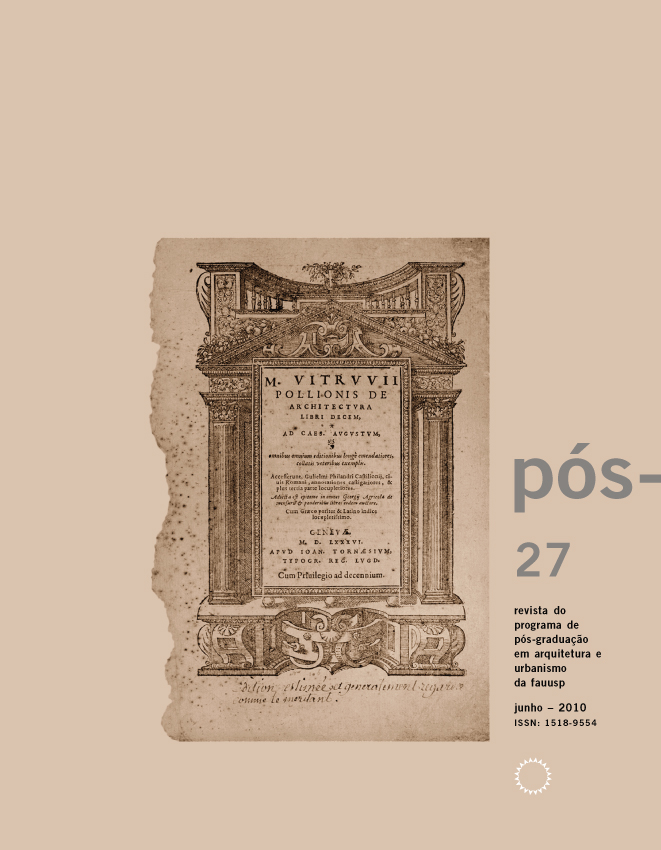An evaluation system for healthcare buildings
DOI:
https://doi.org/10.11606/issn.2317-2762.v0i27p174-192Keywords:
Hospital design and construction, controlled environment, treatment outcome, health evaluation, decision-making, cross-cultural comparisonAbstract
The present article discusses healthcare buildings, from the perspective of Healthcare Economics, focused on the need for healthcare delivery efficiency and the optimization of the respective resources. An important variable that affects the efficiency of the patient's recovery is the perception of both the patient and the staff regarding the facilities where healthcare is provided. The Achieving Excellence Design Evaluation Toolkit (AEDET) system, developed in England, is a tool by which the quality of the healthcare buildings can be evaluated and checked regarding their space perception, function, and technique. The aim of this study was to translate the AEDET into brazilian-portuguese, as well as to adapt it for use in Brazil. The AEDET - Brazil was then applied to the Pirajussara General Hospital. We concluded that the AEDET - Brazil is a toolkit that represents an important advance that can be used to evaluate and assess the quality of healthcare facilities.Downloads
References
BERRY, L. L.; PARKER, D.; COILE, R. C.; HAMILTON, D. K.; O´NEIL, D. D.; SADLER, B. The business case for better buildings. Frontiers of services and management. Baltimore: Hearth Administration Press, v. 21, p. 3-24, 2004.
BROSS, J. C. Requisitos básicos no planejamento hospitalar. O hospital e a visão administrativa contemporânea. São Paulo: PROAHSA, 1989.
CHAD – CENTRE FOR HEALTHCARE ARCHITECTURE AND DESIGN. AEDET (Achieving Excellence Design Evaluation Toolkit. Inglaterra, 2002. Disponível em: http://www.chad.nhsestates.gov.uk. Acesso em: 01 jun. 2004.
CHAD – CENTRE FOR HEALTHCARE ARCHITECTURE AND DESIGN. AEDET Evolution toolkit, Inglaterra, 2004. Disponível em: http´://www.design.dh.gov.uk. Acesso em 04: abr. 2008.
COILE, R. J. Futurescan 2003 – A Forecast of Healthcare Trends 2003-2007 – Health. Filadélfia: Administration Press, 2003.
ENHANCING THE QUALITY OF HEALTH CARE DELIVERY WITH THE BUILT ENVIRONMENT: THROUGH THE PATIENT’S EYES – ACUTE CARE. Boston: The Picker Institute, 1998. 1 videocassete.
FALCÃO, D. M.; CICONELLI, R. M.; FERRAZ, M. B. Translation and Cultural Adaptation of Quality of Life Questionnaire: An Evaluation of Methodology. The Journal of Rheumatology, São Paulo: Unifesp, v. 30, p. 379-385, 2003.
FERRAZ, M. B. A remuneração do trabalho médico. Os médicos e a saúde no Brasil. São Paulo: Conselho Federal de Medicina, 1998.
GUELLI, Augusto. Tradução e adaptação do “AEDET – Achieving Excellence Design Evaluation Toolkit” para utilização no Brasil – Sistema de Avaliação Integral de Edifícios de Saúde. 2006. 42p. Dissertação (Mestrado Profissional em Economia da Saúde) – Universidade Federal de São Paulo, São Paulo, 2006.
GUILLEMIN, F.; BOMBARDIER, C.; BEATON, D. Cross-Cultural Adaptation of Health – Related Quality of Live Measures: Literature Review and Proposed Guidelines. Journal of Clinical Epidemiology, Londres, v. 46, p. 1.417-1.432, 1993.
LAWSON, B. Evidence-based Design for Healthcare. Business Briefing: Hospital Engineering & Facilities Management, Londres, v. 2, p. 25-30, 2005.
NUSBAUM, L.; NATOUR, J.; FERRAZ, M. B.; GOLDEMBERG, J. Translation, Adaptation and Validation of the Roland – Morris Questionnaire – Brazil Roland – Morris. Brazilian Journal of Medical and Biological Research, São Paulo: Unifesp, v. 34, p. 203-210, 2001.
PORTER, M. E.; TEISBERG, E. O. Uma Nova Competição no Setor de Saúde. Harvard Business Review, São Paulo: Segmento RM Editores Ltda., p. 55-67, 2004.
PORTER, M. E.; TEISBERG, E. Repensando a saúde – Estratégias para melhorar a qualidade e reduzir custos. Porto Alegre: Bookman, 2007.
QUALITY LETTER. Health Care Leaders. Designing for quality: Hospital look to the built environment to provide better patient care and outcomes, Baltimore, v. 15, p. 2-13, 2003.
RUBIN, H. R.; OWENS, A. J.; GOLDEN, G. An investigation to determine whether the built environment affects patient’s medical outcomes. Martinês: Center of Health Design, v. 10, p. 11-13, 1998.
RUSS COILE´S HEALTH TRENDS. Healing environment: Progress toward evidence-based. Hager Stown, v. 13, p. 8-12, 2001.
SCHER, P. Patient-focused architecture for health care. Arts of health. Manchester: Metropolitan University, 1996.
VARNI, J. W. An Evaluation of the built environment at children’s convalescent hospital, developmental and behavioral pediatrics. Journal of Developmental and Behavier Pediatries, Texas, v. 25, p. 10-20, 2001.
WESSELS, Lubb. The new dutch integral evaluation system Called “Qind” – Head Building Department – Netherlands board for hospital facilities, the Netherlands. In: 24th SEMINAR UIA – INTERNATIONAL UNION OF ARCHITECTS IN PUBLIC HEALTH WORK PROGRAMME, 2004, São Paulo. Anais... São Paulo: Unifesp, 2004.
Downloads
Published
Issue
Section
License

This work is licensed under a Creative Commons Attribution 4.0 International License.
DIADORIM - Diretório de Políticas Editoriais












